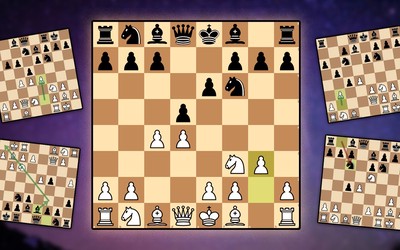
The Minimum Viable (Opening) Repertoire
The Solution To The Amatuer's Opening ProblemsAmong the many chess players who I have talked to over the years, I have met very few who did not enjoy talking about openings.
I have, however, met many players who have struggled to create a complete, yet understandable opening repertoire.
From my observations, the players who have this struggle typically fall into one of two buckets:
a) The ‘Theory Junkie’
This player possesses solid theoretical knowledge from all the books, courses, etc. that they own; but they may have a mediocre understanding of the arising middlegame positions, and often find themselves bogged down in strange, irrelevant computer lines.
b) The ‘Practical Player’
This player has their own set of openings, and experience playing them, but finds it mind-numbingly boring to sit down and take the time to memorize concrete lines from something like an opening book, or Chessable course.
As a result, they often find themselves out of book early on in their games—while never quite getting around to fixing the various holes in their repertoire.
Regardless of which one resonates with you most, today I want to share what I believe could be a suitable solution—and is also my personal approach to openings these days.
Before we arrive at our destination, however, we will need to take a brief detour.
The ‘Minimum Viable Product’ (MVP)
In the realm of business (especially for software), there is a well-known concept, of the ‘Minimum Viable Product’ (MVP, for short).
The underlying concept behind a MVP, is that a business does not want to spend months (or god forbid, years) developing a product—for which ultimately, no one wants.
A MVP is the most bare-bones possible version of the ideal product—to find out whether demand actually exists for it, or not.
As you can probably tell, from the title of the post; I believe that we can apply a similar concept to chess openings—namely, The ‘Minimum Viable Repertoire’ (MVR, for short).
Much like the businessman who spends months making a product that no one wants—there are an overabundance of amatuer players memorizing 100s, probably 1000s of opening lines, that will never get to see the light of day.
The MVR seeks to resolve this issue.
What The MVR Is Not
Before outlining how one can adopt the MVR ‘methodology’, I want to discuss what the MVR is not.
The MVR is not “here’s 10 moves of London theory that you can play against anything Black does”.
It is also not trying to advocate for permanent ‘minimalism’, in terms of the amount of theoretical knowledge that one possesses.
In the same way that the business desires to evolve their product beyond it’s most primitive version—we should be trying to do the same with our openings.
The MVR Methodology
Step 1: Building the Base
Assuming we’re starting from scratch (if not, you may want to skip to step 2)—you want to start simple, and small.
Many players make the mistake of trying to do the exact opposite—where they’ll dive straight into all these super long & complicated lines (I’m definitely guilty of having done this). Half the time, however, they can’t even remember the preceding moves that led them down that rabbit hole in the first place.
“OK—so how small, though?” you may ask.
This will ultimately depend on your level.
For example, let’s say we have a player rated 1000, looking to play 1.e4 e5 with the Black pieces.
I would start by going to the lichess DB, and filtering by games of players rated ~1000.
After entering 1.e4 e5, we get the following list:
At this early stage, I would take the top 5 moves (2.Nf3, 2.Bc4, 2.d4, 2.Qh5, and 2.Nc3), and literally just enter a one move response to each of these.
(Note:
I will caution against using the 1000 rated lichess DB for generating your responses—since the quality of moves is generally not going to be super high. I would try to refer to either the engine’s top move (be careful with this, though), the top move in the Master’s DB, or the recommendation of a reliable opening book/course.)
For someone who is 1800, let’s say—then of course, a slightly larger 'base' is necessary.
I would follow the same process described above, except going let’s say 6-7 moves deep on average, and building your own equivalent of a Chessable course’s ‘Quickstarter Guide’.
For example, if you wanted to play the Open Sicilian as White—I would pick a setup that looks promising against each of Black’s major choices, but avoid getting any deeper, for now.
I know, it’s not much—but again, that’s the whole point.
Step 2: Play
Personally, I’m a big advocate of incorporating blitz into my training—in large part, as a means for improving the quality of my openings.
Generally speaking, however, I find that the lower rated you are, the more rapid/classical should take preference over blitz.
Blitz allows for more volume, but has the potential drawback of being deficient in quality.
Regardless of time control, however, nothing can beat the actual raw experience of repeatedly putting one’s openings to the test in the battlefield.
For example, let’s say we have two players who both play the Sicilian Najdorf—Player A and Player B:
Player A has read an entire 500 page book on the Najdorf, but has not yet dared to play the opening in even a single blitz game (I’ve been guilty of this).
Player B, on the other hand, might have never read a book on the Najdorf in his life, but has the practical experience of playing 100+ games with it, and may know 50-100 lines by heart.
Player A “knows” the opening, but Player B lives the opening.
Step 3: Review + Add Notes
To be honest, Step 2 is pretty easy.
More or less, everyone does Step 2 in some capacity (apart from the extreme Player A-types).
Unfortunately, to their detriment, most players skip this crucial step—of actually reviewing their games.
For myself—either at the end of a blitz session, or after each individual game, I will examine the opening phase of the game with a DB and engine (or again—also potentially a book/course, if I have one on the given opening).
If I was faced with a new, or unknown idea, I will usually edit my corresponding opening file, and add a couple moves + annotations as needed to address that gap in my knowledge.
For example, let’s say you currently have up until 1.e4 e5 2.Nf3 Nc6 3.Bc4 Nf6 4.d3 in your opening files for Black.
Now imagine, in your next game, you have an opponent who plays 4.Ng5!?, trying to go for the direct kill.
Not knowing how to adequately respond, you try playing 4...d5 5.exd5 Nxd5?!, falling victim to the classic Fried Liver after 6.Nxf7!.
After the game, realizing something went terribly wrong—you can consult with the engines + DB (or a reference source, such as an opening book/course—which has the benefit of annotations to explain all the moves) to see that 5...Na5 was a much better alternative to 5...Nxd5?!, and then add this information to your opening file.
Because the position is also quite forcing, it may make sense to play around a bit more, and add the following moves: 6.Bb5+ c6 7.dxc6 bxc6.
At most, this should only really take an extra minute or two to really figure out after the game, given the modern tools we have at our disposal.
Admittedly, this is really just where the theory begins, but for the purposes of the MVR, it is sufficient to know until this point (for now).
This ensures that the theory we are consuming is actually relevant to our practice—and we are not just memorizing moves for the sake of memorizing moves.
To reinforce the point, however, let us go back to the Open Sicilian example, from Step 1—in particular with the 6.Bg5 Najdorf.
Let’s say you have a game that goes 6.Bg5 e6 7.Qd2 h6 8.Bh4 Be7 9.0-0-0 0-0, with a sharp opposite-side castling position, that you later went onto win.
After such a win, many players wouldn’t bother to check the opening, assuming that everything went pretty smoothly.
Unfortunately, in this case, if we were to go back to the position after 8.Bh4, a quick check with the engine and DB should reveal something quite disturbing.
Yes—8.Bh4 is actually a blunder. Black wins a pawn via tactical means, with the nasty 8...Nxe4!.
However, the other alternatives for White after 7...h6 are also not too appealing (8.Bxf6, and 8.Be3 Ng4—both of which allow Black to win White’s precious DSB, and hence equalize fairly easily).
So, going back even further, we can see that after 6.Bg5 e6, 7.Qd2 is in fact already a bit innacurate.
Rather, the correct approach is for White to play 7.f4!, where they will usually bring their queen to f3, and proceed to castle long.
Again, with the MVR approach—we will stop at this point for now. Or, at most just go 2-4 moves deeper, to get a sense of where some of our pieces will be placed and what not.
Step 4: Repeat Steps 2-3 (For As Long As You Can Breathe)
At this point, it really just becomes an iterative process.
We play games to gain experience in our desired openings, while incrementally expanding our knowledge base in the lines that we are actually facing in practice.
As a reminder—this process relieves the burden of trying to learn everything at once, and instead allows for a more gradual, steady improvement of one’s openings.
Conclusion
Ultimately, the purpose of this post is not to give some easy shortcuts to revamping one’s entire repertoire within a matter of hours.
(There’s a reason this post is not titled ‘The 4-Hour Opening Repertoire’.)
Rather, it is for those who want a simple, systematic, repeatable framework that can be used for improving their openings, while being sustainable over a longer time horizon.
With this approach—we also ensure that our openings are being worked on/refined year-round. For tournament players, this avoids the dreaded pre-tournament ritual, that many players find themselves stuck in—of cramming 1000s of opening lines the nights leading up to (or worse—during!) the big tournament.
If you enjoyed this post, make sure to subscribe to my newsletter (https://roadtoinfinity.substack.com/), to get these posts sent straight to your inbox.


